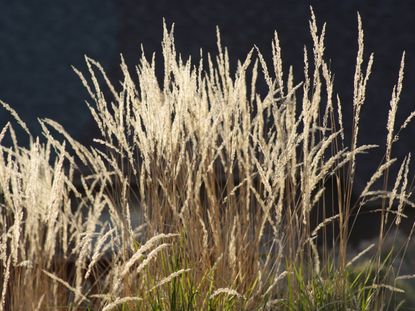What Is Blue Grama Grass: Information On Blue Grama Grass Care


Native plants are becoming more popular in garden and home landscape use due to their low maintenance and ease of care. Choosing plants that already fit into the local fauna gives them a high incidence of survival and growth with minimal effort because the area already matches their requirements. This reduces the use of herbicides, pesticides, and even water, and provides a sustainable landscape that blends and accents the natural region. Blue grama grass (Bouteloua gracilis) is a bunch grass native to the Great Plains found in pastures, grazing land, and open unmanaged fields. Some information and knowledge on what is blue grama grass will help you decide if it is a good fit for your location.
What is Blue Grama Grass?
Blue grama cultivars are part of turf grass and ground cover areas with low moisture. It is a warm to temperate zone grass that requires sun and dry earth but tolerates a range of soil types, from rocky to sandy, with moderate to alkaline pH levels. About the only condition it cannot stand is boggy or overly wet sites. It is a low growing grass that spreads from rhizomes and spreads slowly. The native perennial is found across North America in plains, mesas and even open woodlands. When mixed with other turf grass species, it makes an excellent low maintenance lawn.
Blue Grama Information as Turf Grass
The native grass starts growing in May to June and flowers at the end of the summer season. It is often used for grazing but also performs well as a lawn with minimal mowing, watering or fertilizing. It is not suitable for most northern climes and performs best in western Colorado, Utah, New Mexico, and Arizona, although it tolerates drier parts of the Pacific Northwest. ‘Hachita' is the most drought tolerant of the blue grama grass cultivars but ‘Loving' and ‘Alma' are also high performers with ease of care and low maintenance requirements. One of the more important pieces of blue grama information is its ability to be used as an ornamental. None of the varieties gets taller than 12 to 18 inches (30-45 cm.) without mowing and they produce abundant purplish inflorescences in late summer that are attractive and provide delightful movement and wild animal fodder.
Planting Blue Grama Grass
The ideal time for planting blue grama grass is two months before the first frost in fall. Prepare a seed bed by tilling the area and adding compost or mixed grit to ensure drainage and percolation. Rake out any imperfections and debris and grade the area. The seed is fine and should be mixed with sand for sowing at a rate of 3 pounds (1.3 kg.) per 1,000 feet (305 m.). You can load a seed spreader to the desired ratio and then lightly water the area after application. Keep the bed moist in spring, but not soggy, until germination which generally occurs within 7 to 10 days once soil temperatures warm up.
Blue Grama Grass Care
This lovely fine-leaved bluish grass is easy to maintain and requires little of the standard turf grass treatment that other cultivated varieties seem to demand. If you do fertilize, feed in early spring with a low nitrogen grass feed. The grass has no thatch buildup and grows slowly, which requires minimal mowing. Mow at a high level of approximately 4 inches (10 cm.) for best grass health. The biggest problem with the plant is rust, fungal rot, or smuts. Any of these can be prevented for the most part by following good blue grama grass care and only watering in extreme drought and only when the blades of grass have time to dry in the coolest part of the day. Wet foliage in high heat tends to form the fungal diseases that cause these major problems.
Gardening tips, videos, info and more delivered right to your inbox!
Sign up for the Gardening Know How newsletter today and receive a free download of our most popular eBook "How to Grow Delicious Tomatoes."

Bonnie Grant is a professional landscaper with a Certification in Urban Gardening. She has been gardening and writing for 15 years. A former professional chef, she has a passion for edible landscaping.
-
 10 Best Apartment Plants To Turn Your Small Space Into An Oasis
10 Best Apartment Plants To Turn Your Small Space Into An OasisThe best apartment plants can lend an ambience of the tropics, brighten up a space, or add a touch of drama, and turn an apartment into a relaxing oasis.
By Amy Grant
-
 Grow a Bathroom Oasis: 8 Best Bathroom Plants With No Light or Low Light
Grow a Bathroom Oasis: 8 Best Bathroom Plants With No Light or Low LightSome apartment dwellers grow the best bathroom plants with no light or low light. Read how one of our favorite plant lovers does it in the big city.
By Teo Spengler